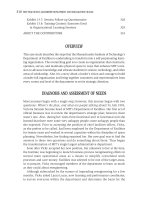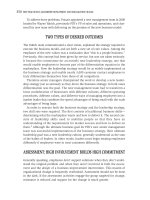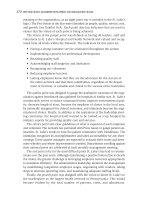Tài liệu Best Practives in Leadership Development & Organization Change 36 doc
Bạn đang xem bản rút gọn của tài liệu. Xem và tải ngay bản đầy đủ của tài liệu tại đây (169.18 KB, 10 trang )
320
BEST PRACTICES IN LEADERSHIP DEVELOPMENT AND ORGANIZATION CHANGE
processes, demanding clients, rapidly increasing technologically sophisticated
systems, and increasingly stringent regulations. Members of the MIT commu-
nity and MIT’s physical assets, its buildings and grounds, benefit from highly
skilled facilities personnel. The Learning and Performance Center is imple-
menting more technical skills training along with many courses in diversity,
management, computers, leadership, and safety.
• How does Facilities measure the value of its service in terms of the inter-
nal and external customer? At the completion of every service request by
Repair and Maintenance, the functional unit responsible for all of the repairs
to existing building structures and systems, and Design and Construction Ser-
vices, the functional unit responsible for all renovations, the internal or exter-
nal customer is asked to provide feedback on the quality of the service.
Returned evaluations are reviewed and changes implemented if necessary.
Learning and Performance measures the value of its training in the workplace
with an evaluation form that is distributed at the conclusion of every course
and by way of dialogue sessions one to two months following the conclusion
of select courses. The form asks questions about the specific course and for
suggestions regarding new courses, and the dialogue focuses on the applica-
tion of new skills and knowledge. Very few historical statistical data are avail-
able; therefore, longitudinal studies are not possible at this time. Facilities is
beginning to collect data and expand measurement capabilities to other func-
tional units.
At this early stage of its development, Facilities’ learning organization effort
is fragile and requires unflagging vigilance, much maintenance, and continu-
ous, consistent, and strong leadership. The primary elements for growth are
already in place: the realization by many employees that to be successful in the
long-term, Facilities must become a learning organization; a visionary chief facil-
ities officer; a few enlightened leaders; and a cadre of informal leaders to sus-
tain this growth and lead, influence, and motivate the rest of the organization
throughout the many changes and transformations that will be occurring.
Facilities’ journey is clearly under way.
The journey of a thousand miles starts from beneath your feet.
—Lao Tzu, Tao Te Ching, Book Two, Chapter 64
REFERENCES
Burke, W. W. (2001). Competency Model. OD Practitioner, 33(3), 15.
Cashman, K. (1998). Leadership from the Inside Out. Provo, Utah: Executive
Excellence Publishing.
cart_14399_ch13.qxd 10/19/04 1:15 PM Page 320
MIT
321
Dannemiller, K. (Oct. 2001). “Whole Scale Change.” Paper presented at Linkage
Organization Development Summit, Chicago, Ill.
Lao Tzu (4th century B.C./1963). Tao Te Ching, D. C. Lau (trans.). Baltimore, Md.:
Penguin.
Senge, P. (1990). The Fifth Discipline: The Art and Practice of the Learning Organization.
New York: Doubleday.
Ulrich, D., Zenger, J., and Smallwood, N. (1999). Results-Based Leadership. Boston,
Mass.: Harvard Business School Press.
cart_14399_ch13.qxd 10/19/04 1:15 PM Page 321
322
BEST PRACTICES IN LEADERSHIP DEVELOPMENT AND ORGANIZATION CHANGE
Exhibit 13.1. Status of Strategic Plan Action Items, 1999 and 2002
Number of Action Items
1999 2002
Complete 29 45
Partially complete 16 10
In progress 5 1
No action 6 0
Note: “Partially complete” refers to an action item with several deliverables where at least one but
not all of the deliverables are complete; whereas, “in progress” refers to an action item with
several deliverables where none are complete.
Prior to Strategic Plan Following Strategic Plan
Training centrally documented for
27 percent of employees
Fourteen courses were offered
annually to unionized service staff
Thirty computers plus thirty
terminals were in use
Only select individuals received
computer training
Training was generally focused on
technical issues
Annual performance reviews for
administrative staff were conducted
informally and inconsistently
Administrative assistants did not
receive annual performance reviews
Training documented for all employees
Forty-five individual courses were offered
to all employees in 1998, one year fol-
lowing the formation of the Learning and
Performance Team. Currently Learning
and Performance offers a similar number
of courses; however, many of the original
courses have been updated or replaced
with those addressing current needs.
Four hundred computers are in use
All employees receive training in elec-
tronic mail and web fundamentals
Learning is aligned to strategic goals
The annual performance review process
for administrative staff is formal and
consistently applied
Administrative assistants receive annual
performance evaluations
cart_14399_ch13.qxd 10/19/04 1:15 PM Page 322
MIT
323
Exhibit 13.1. (Continued)
Unionized service staff did not
receive annual performance reviews
Recognition for good work was
dependent upon a customer sending
praise to the employee by the way
of a letter. The letter would be
placed in the employee’s file
No customer involvement in
strategic decisions
The receipt of a repair request is not
acknowledged
Select employees communicate with
customers
Unionized service staff participate in an
annual performance feedback session with
their coach
Employees recognize each other for doing
good work. All cash rewards are tied to
strategic goals. Praise from customers is
welcome, but most recognition originates
from within Facilities.
Customers participate in the decisions that
could affect the strategic direction of
Facilities
An acknowledgment for the receipt and
completion of each repair request is sent
to the customer automatically
All employees communicate with
customers
cart_14399_ch13.qxd 10/19/04 1:15 PM Page 323
324
BEST PRACTICES IN LEADERSHIP DEVELOPMENT AND ORGANIZATION CHANGE
Exhibit 13.2. Systems Diagram
To read the systems diagram:
The strong, respected leadership consistently demonstrated by the chief facilities
officer, Vicky Sirianni, has influenced informal leaders to take the initiative to
implement new processes and practices, which then leads up to the intervention:
having the organizational learning disciplines directly linked to the strategic goals
of the department. This is not a one-time intervention. On-going initiatives
have been and currently are being developed. Over time, the objectives of these
initiatives are to lead to (a) changes in culture by having new practices and ways
of interacting and (b) employees continually learning and striving for the next
levels of growth.
Start here
Intervention
s
s
Over time
Over time
s
s
s
R
Informal leaders
willing to take
new initiatives
Next level of
growth and
development
Strong, respected
leadership
(from director)
Organizational
learning disciplines
linked directly to
strategic goals
Changes in
culture
Note: The “s” indicates increases in growth or the direction of influence in a positive direction.
cart_14399_ch13.qxd 10/19/04 1:15 PM Page 324









